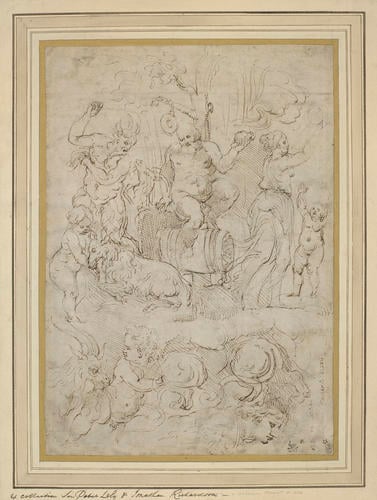-
1 of 253523 objects
A Bacchic scene and other sketches; the Fall of Phaethon, and an architectural sketch. c.1533
Pen and ink and black chalk under drawing | 34.0 x 25.7 cm (sheet of paper) | RCIN 990505

Raffaello da Montelupo (1504/5-1566/7)
A Bacchic scene and other sketches; the Fall of Phaethon, and an architectural sketch c.1533

Raffaello da Montelupo (1504/5-1566/7)
A Bacchic scene and other sketches; the Fall of Phaethon, and an architectural sketch c.1533


-
A pen and ink drawing of a bacchic scene; on the verso, the Fall of Phaeton and an architectural sketch.
On the verso is an architectural sketch of a three-bay form with a complex pediment. Below is a sketch of a composition of the Fall of Phaethon, clearly based on Michelangelo’s ‘presentation drawing’ also at Windsor (RCIN 912766), rather than on his versions of the same subject in London and Venice. It was presumably made when Raffaello was collaborating with Michelangelo in mid-1533. He probably saw Michelangelo at work on the original drawing, but the variant positions of the arms of the Heliades are more likely his own experiments than records of Michelangelo’s ideas. His copy, which makes no effort to record the detail of the original but which does capture something of its energy, is a vivid example of Raffaello’s pen style at its loosest and most rhythmical. Such flowing pen work is rare among his drawings but it reveals a draughtsman of greater vitality than most of his surviving work would suggest. Shortly after the present copy, he made a copy, also in pen, of the Bacchanal of Children (RCIN 912777), now in the Ashmolean (Parker 410).
Raffaello sketched the Fall of Phaethon after the architectural form had been drawn on the sheet, for he had to change the layout of the Phaethon to fit his sketch into the available space. This architectural scheme, perhaps for an altar, is not directly related to any known Michelangelo drawing but the arrangement reflects some of Michelangelo’s architectural ideas, as illustrated in various projects for altars and perhaps, freestanding tombs. The relation of the reclining figures and the volutes on either side of the crowning pediment suggest that Raffaello was familiar with early designs for the tombs in the New Sacristy in San Lorenzo, Florence, and the diamond like form in the centre of the broken pediment – itself based on the sarcophagus lids of the ducal tombs – may indicate a Medici project.
That Raffaello made free use of Michelangelo’s ideas with some confidence is also shown by the upper drawing on the recto of the sheet. The Bacchic scene is partly inspired by Michelangelo’s drawings of children at play, such as that on the verso of the drawing in the Getty Museum (93.GB.51), and his design for a relief of the Nymphs in the Garden of the Hesperides, an early design for the Medici tomb that is known in developed forms only in copies (for example, Uffizi 607E). The scene may also be indebted to Michelangelo’s project for a painting – probably the Bacchanal of the Andrians – for the camerino d’alabastri of Alfonso d’Este, a project for which a figure study has been identified (Louvre 697). In Raffaello’s composition, however, Michelangelo’s forms are much coarsened. A faint echo of the drawing can be found in the allegorical relief on the tomb of Jacopo Sannazzaro in Santa Maria del Parto in Naples, which was worked on by Montorsoli, Silvio Cosini, and Bartolomeo Ammanati: the first two had assisted Michelangelo and the third knew his work well. That Raffaello was ready to parody Michelangelo’s forms and ideas is evident in a drawing in the Rijksmuseum (RP-T-1981-23), a Sleeping Venus based on Michelangelo’s Dawn, surrounded by a group of delinquent putti based on Michelangelo’s Dream (Courtauld Gallery).
The sheet is inscribed on the recto in pen and ink, possibly in the hand of the artist: ‘pacis Ultima Copia / fecit raffaello’.
Text adapted from P. Joannides, Michelangelo and his Influence. Drawings from Windsor Castle, London 1996, no. 10.
-
Creator(s)
-
Medium and techniques
Pen and ink and black chalk under drawing
Measurements
34.0 x 25.7 cm (sheet of paper)
Markings
watermark:
anchor in circle with star, not in Briquet